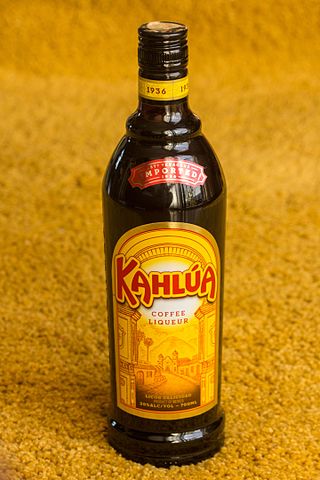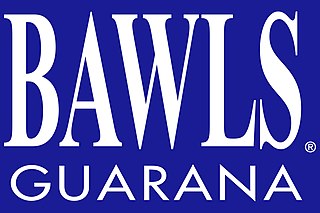Related Research Articles

Coca-Cola, or Coke, is a carbonated soft drink manufactured by the Coca-Cola Company. In 2013, Coke products were sold in over 200 countries worldwide, with consumers drinking more than 1.8 billion company beverage servings each day. Coca-Cola ranked No. 87 in the 2018 Fortune 500 list of the largest United States corporations by total revenue. Based on Interbrand's "best global brand" study of 2020, Coca-Cola was the world's sixth most valuable brand.

Irn-Bru is a Scottish carbonated soft drink, often described as "Scotland's other national drink". Introduced in 1901, the drink is produced in Westfield, Cumbernauld, North Lanarkshire, by A.G. Barr of Glasgow.

Kahlúa is a brand of coffee liqueur owned by the Pernod Ricard company and produced in Veracruz, Mexico. The drink contains rum, sugar, and arabica coffee.

Red Bull is a brand of energy drinks created and owned by the Austrian company Red Bull GmbH. With a market share of 38%, it is the most popular energy drink brand as of 2019, and the third most valuable soft drink brand behind Coca-Cola and Pepsi. Since its launch in 1987, more than 100 billion cans of Red Bull have been sold worldwide, including over 11.5 billion in 2022.

An energy drink is a type of drink containing stimulant compounds, usually caffeine, which is marketed as providing mental and physical stimulation. They may or may not be carbonated and may also contain sugar, other sweeteners, herbal extracts, taurine, and amino acids. They are a subset of the larger group of energy products, which includes bars and gels, and distinct from sports drinks, which are advertised to enhance sports performance. There are many brands and varieties in this drink category.

A caffeinated drink, or caffeinated beverage, is a drink that contains caffeine, a stimulant that is legal practically all over the world. Some are naturally caffeinated while others have caffeine added as an ingredient.

Bawls is a non-alcoholic, highly-caffeinated soft drink.

The nutrition facts label is a label required on most packaged food in many countries, showing what nutrients and other ingredients are in the food. Labels are usually based on official nutritional rating systems. Most countries also release overall nutrition guides for general educational purposes. In some cases, the guides are based on different dietary targets for various nutrients than the labels on specific foods.

Krating Daeng is a non-carbonated energy drink created by Chaleo Yoovidhya. The drink is marketed and sold primarily in Southeast and East Asia; its derivative, Red Bull, is available worldwide in 165 countries.

Four Loko is a line of alcoholic beverages sold by Phusion Projects of Chicago, Illinois, United States. Four Loko's recipe formerly included caffeine. Phusion operates as Drink Four Brewing Company. Four Loko, the company's most popular beverage, debuted in the United States market in 2005 and is available in 49 states, and in 21 countries including Ecuador, Guatemala, Paraguay, The Bahamas, Peru, Mexico, Colombia, Bolivia, Honduras, El Salvador, Nicaragua, Costa Rica, China, Canada and some countries in Europe. The name "Four" is derived from the original drink having four "key ingredients".
Cocaine, also known as No Name, is a highly caffeinated energy drink distributed by Redux Beverages. It contains more caffeine than rival energy drinks Red Bull and Rockstar, symbolized by three and a half steer heads on the label. Aside from caffeine, the label claims 750 milligrams of taurine, another common ingredient found in many energy drinks.

Bang is an American brand of energy drinks. It is made by Vital Pharmaceuticals, a corporation located in Florida. As of 2020, Bang is the third highest selling energy drink in the United States, behind Monster and Red Bull.

Blue Sky Beverage Company was a beverage company that produced soft drinks and energy drinks. It is a wholly owned subsidiary of the Monster Beverage Corporation. The company was established in Santa Fe, New Mexico, in 1980, where it remained until it was purchased by Monster in 2000. Coca-Cola North America took ownership of Blue Sky Sodas, Hansen’s Juice Products, Hansen’s Natural Sodas, Hubert’s Lemonade, Peace Tea and other non-energy drink brands as part of Coke’s partnership with Monster Beverage Corp on Jun 12, 2015. Blue Sky Beverage Company now operates out of Corona, California. The southwestern look and feel of the artwork on the soda cans is reminiscent of the company's roots in New Mexico.
5-hour Energy is an American-made "energy shot" manufactured by Living Essentials LLC. The company was founded by CEO Manoj Bhargava and launched in 2004.

The 17 November 2010 United States ban on caffeinated alcoholic drinks is a ban which prevents the marketing and distribution of any prepackaged caffeinated alcoholic drink.

Zevia is a Los Angeles-based company that produces soft drinks, organic tea, energy drinks, and mixers sweetened with stevia. All Zevia products are zero-calorie, sugar-free, gluten-free, vegan, certified kosher, and certified by The Non-GMO Project. In June 2021, Zevia filed to go public with an IPO.

Nae Danger is an energy drink from Scotland. It is claimed to be the first and only carbonated energy drink to have been created, branded and manufactured in Scotland, which is contested with IrnBru32 which was released in 2006 by A.G. Barr. Released in August 2012, the drink is a creation of Ross Gourlay, a Scottish entrepreneur from Bishopbriggs. Gourlay hoped to gain a slice of the growing caffeinated drinks market and also encourage recognisable Scottish brands within the UK. There are two main flavours: Blue Raspberry and Red Blueberry.
Live+ is an energy drink marketed to New Zealanders by Monster Beverage Corporation. It was originally known as Lift+ or Lift Plus and created and produced by Coca-Cola Amatil based on the soft drink Lift.
Prime is a range of sports drinks, drink mixes, and energy drinks created and marketed by Prime Hydration, LLC. The range is promoted by YouTubers Logan Paul and KSI. The announcement and the release of the product in 2022 was followed by a social media hype associated with these social media personalities, who have tens of millions of followers combined. It was also promoted through mainstream sports sponsorship deals.
References
- ↑ Bruce, Bill (2009-06-02). "Demon Energy launches Demon Energy Shots". FoodBev Media. Archived from the original on 2016-09-23. Retrieved 2021-11-07.
- ↑ "Energy drink linked to psychotic episodes". NZ Herald. Retrieved 2021-11-09.
- ↑ "Energy drink uses sex to sell". Stuff. 18 February 2009. Retrieved 28 November 2021.
- ↑ "Experts worry about caffeine levels in energy drinks". NZ Herald. Retrieved 2021-11-09.
- ↑ Keith Lynch (23 June 2009). "Caffeine drinks investigated". Stuff. Retrieved 28 November 2021.
- ↑ "Energy drinks well over limit". New Zealand Herald. 3 October 2009. Retrieved 28 November 2021.
- ↑ Nathan Beaumont (19 August 2009). "Change to energy drink labels considered". Dominion-Post. Retrieved 28 November 2021– via PressReader.
- ↑ "Call for mandatory warnings on energy drinks". RNZ. 17 August 2009. Retrieved 28 November 2021.
- ↑ Rebecca Todd (28 October 2009). "Scientific evidence on safety of energy drinks weighed". Stuff. Retrieved 28 November 2021.
- ↑ "Soldiers photos no stunt – Demon Drinks". New Zealand Herald. 18 September 2009. Retrieved 28 November 2021.
- ↑ Day, Matthew (2012-08-13). "'Demon' energy drink 'can promote evil'". The Telegraph. Archived from the original on 2012-08-14. Retrieved 2021-11-07.
- ↑ "BEHEMOTH Frontman Is The New Face Of 'Demon' Energy Drink". Blabbermouth. 2012-07-30. Archived from the original on 2021-11-07. Retrieved 2021-11-07.
- ↑ Dawiec, Monika (2012-10-01). "Agros-Nova przystąpiła do samoregulacji reklamy napojów energetycznych" [Agros-Nova has started to self-regulate the advertising of energy drinks]. HurtiDetal.pl (in Polish). Archived from the original on 2021-11-07. Retrieved 2021-11-07.
- ↑ "Najpierw bojkotowali producenta napoju Demon, teraz atakują pracownicę firmy. Internetowa burza wokół Agros-Nova" [First they boycotted the manufacturer of the drink Demon, now they attack an employee of the company. Internet storm around Agros-Nova]. naTemat.pl (in Polish). 2012-09-03. Archived from the original on 2012-09-06. Retrieved 2021-11-07.